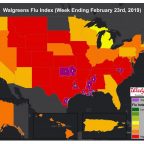Apple and Pizza Vie for Americans’ Favorite Pie
As millions around the world today indulge in pie to celebrate the mathematical concept of pi (the Greek symbol used to represent the ratio between a circle’s circumference and its diameter, or approximately 3.14159), The Harris Poll has found that, for Americans, apple pie reigns supreme (12%), but pizza comes in a close second (10%) and is, by far, the favorite type of pie among men ages 18-34 (25%).
More than 7 in 10 U.S. adults (72%) prefer sweet pies over savory pies, and most agree that the best part of pie is the filling (69%), while about 3 in 10 say the best part is the pastry or crust (31%).
These are some of the results of The Harris Poll® of 2,178 U.S. adults aged 18+ surveyed online between March 6 and 8, 2017.
Pie vs. cake
When it comes to dessert, Americans are nearly evenly split, with a slight preference for cake (52%) over pie (48%) – particularly in the South, where about 6 in 10 prefer cake (61% South), but not in the Midwest where 58% of adults prefer pie.
•Women (56%) and young adults ages 18-34 (66%) are particularly likely to prefer cake, while men (53%) and adults ages 35+ are more likely to choose pie (53% 35-44, 47% 45-54, 51% 55-64, 59% 65+).
If eating pie for dessert, not everyone screams for ice cream: over half of U.S. adults (56%) – though nearly 2 in 3 young adults ages 18-34 (64%) – like their pie a la mode, while more than 4 in 10 like it without ice cream (44%).
Methodology
This Harris Poll was conducted online, in English, within the United States between March 6 and 8, 2017 among 2,178 adults aged 18+. Figures for age, sex, race/ethnicity, education, region and household income were weighted where necessary to bring them into line with their actual proportions in the population. Propensity score weighting was also used to adjust for respondents’ propensity to be online.
All sample surveys and polls, whether or not they use probability sampling, are subject to multiple sources of error which are most often not possible to quantify or estimate, including sampling error, coverage error, error associated with nonresponse, error associated with question wording and response options, and post-survey weighting and adjustments. Therefore, The Harris Poll avoids the words “margin of error” as they are misleading. All that can be calculated are different possible sampling errors with different probabilities for pure, unweighted, random samples with 100% response rates. These are only theoretical because no published polls come close to this ideal.
Respondents for this survey were selected from among those who have agreed to participate in Harris Poll surveys. The data have been weighted to reflect the composition of the adult population. Because the sample is based on those who agreed to participate in our panel, no estimates of theoretical sampling error can be calculated.






